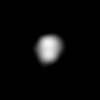Belinda (księżyc)
| ||
 Zdjęcie Belindy, wykonane przez sondę Voyager 2 | ||
| Planeta | Uran | |
| Odkrywca | Stephen Synnott, Voyager Imaging Team | |
| Data odkrycia | 13 stycznia 1986 | |
| Tymczasowe oznaczenie | S/1986 U5 | |
| Charakterystyka orbity | ||
| Półoś wielka | 75 300 km[1] | |
| Mimośród | 0,0001[1] | |
| Okres obiegu | 0,624 d[1] | |
| Nachylenie do płaszczyzny równika planety | 0,031°[1] | |
| Długość węzła wstępującego | 279,337°[1] | |
| Argument perycentrum | 42,406°[1] | |
| Anomalia średnia | 357,224°[1] | |
| Własności fizyczne | ||
| Wymiary | 128 × 64 × 64 km | |
| Powierzchnia | ~25 000 km² | |
| Objętość | ~380 000 km³ | |
| Masa | 4,9 × 1017 kg | |
| Średnia gęstość | 1,3 g/cm³ | |
| Przyspieszenie grawitacyjne na powierzchni | 0,014 m/s² | |
| Prędkość ucieczki | 34 m/s | |
| Okres obrotu wokół własnej osi | synchroniczny | |
| Albedo | 0,08 | |
| Jasność obserwowana (z Ziemi) | 21,0m | |
| Temperatura powierzchni | 64 K | |
Belinda (Uran XIV) – jeden z wewnętrznych księżyców Urana. Został odkryty 13 stycznia 1986 roku na zdjęciach przesłanych przez sondę Voyager 2. Nie wiadomo o nim praktycznie nic, oprócz parametrów orbity i rozmiaru.
Nazwa pochodzi od imienia bohaterki sztuki Pukiel włosów ucięty Alexandra Pope’a.
Istnieje również paronimiczna planetoida o nazwie (654) Zelinda.
Zobacz też
Przypisy
Linki zewnętrzne
- Belinda (ang.). W: Solar System Exploration [on-line]. NASA. [dostęp 2018-12-25].
Media użyte na tej stronie
This is a revised version of Solar_System_XXIX.png.
This image of Uranus was compiled from images returned Jan. 17, 1986, by the narrow-angle camera of Voyager 2. The spacecraft was 9.1 million kilometers (5.7 million miles) from the planet, several days from closest approach. This picture has been processed to show Uranus as human eyes would see it from the vantage point of the spacecraft. The picture is a composite of images taken through blue, green and orange filters. The darker shadings at the upper right of the disk correspond to the day-night boundary on the planet. Beyond this boundary lies the hidden northern hemisphere of Uranus, which currently remains in total darkness as the planet rotates. The blue-green color results from the absorption of red light by methane gas in Uranus' deep, cold and remarkably clear atmosphere.
벨린다.



